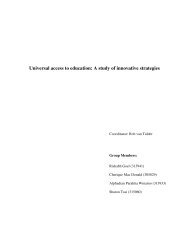here - ERIM - Erasmus Universiteit Rotterdam
here - ERIM - Erasmus Universiteit Rotterdam
here - ERIM - Erasmus Universiteit Rotterdam
Create successful ePaper yourself
Turn your PDF publications into a flip-book with our unique Google optimized e-Paper software.
A validation Study of House of Quality key performance indicators<br />
community as a group of individuals who cooperate to share resources and satisfy each<br />
other’s needs.<br />
Relationships; virtual communities offer people with the same interests of/ or problems the<br />
possibility to come together within the virtual community. By frequently interacting within<br />
the virtual community, strong and personal relationships may be formed. Sociability, or social<br />
interaction, is a key ingredient in building social capital in virtual communities. Social capital<br />
is fundamental to the sustenance of the community and encourages members to collaborate<br />
and cooperate with each other for a common purpose (Preece 2002).<br />
Fantasies; members in virtual communities can share different fantasy experiences they<br />
have. For example; members can engage in role-playing games w<strong>here</strong> everything seems to<br />
be possible.<br />
Transaction; in the virtual community members can make economical transactions. For<br />
example goods can be sold to other members like at markplaats.nl<br />
As a growing interest and influence of virtual communities is assured, Kozinets (1999) emphasizes<br />
that “unlikely to replace physical encounters or information from traditional media, online<br />
interactions are becoming an important supplement to social and consumption behavior”.<br />
2.3.2 Typology of virtual communities<br />
According to De Valck (2005) virtual communities can be used for a wide range of different topics but<br />
vary greatly due to (1) their main purpose, (2) the computer-mediated context in which they occur,<br />
and (3) their organizational structure. The first type of segmentation, main purpose, is most relevant<br />
for this particular research and will be discussed more deeply below followed by a brief discussion of<br />
the other two types of segmentation.<br />
Segmentation by main purpose<br />
As mentioned above, virtual communities are organized around different topics. Also many different<br />
typologies to distinguish virtual communities are known. The most well known typology is made by<br />
Hagel and Armstrong (1997). They made a distinction of communities based on the purpose for<br />
which they are organized: communities of relationships, communities of interest, communities of<br />
fantasy and communities of transaction:<br />
Communities of relationships; within this type of communities members have something in<br />
common or are in the same situation. For example a common illness, being single or having<br />
the same job.<br />
29
















